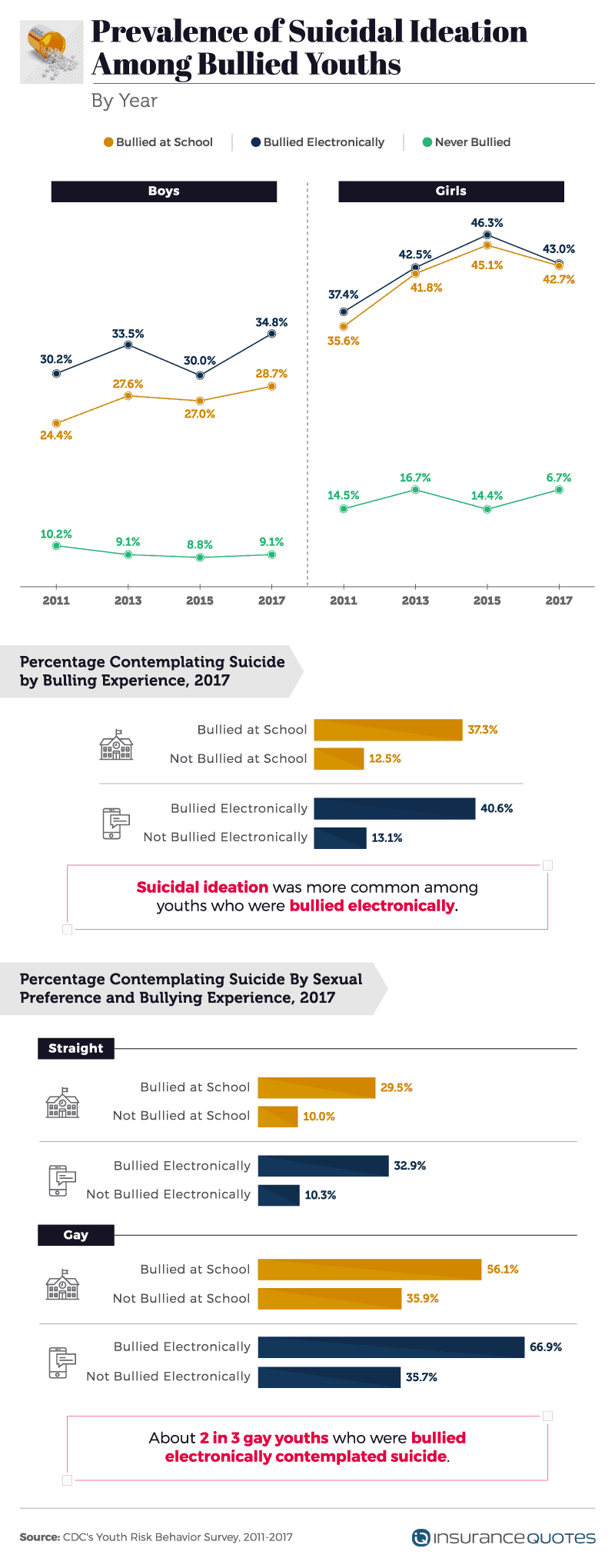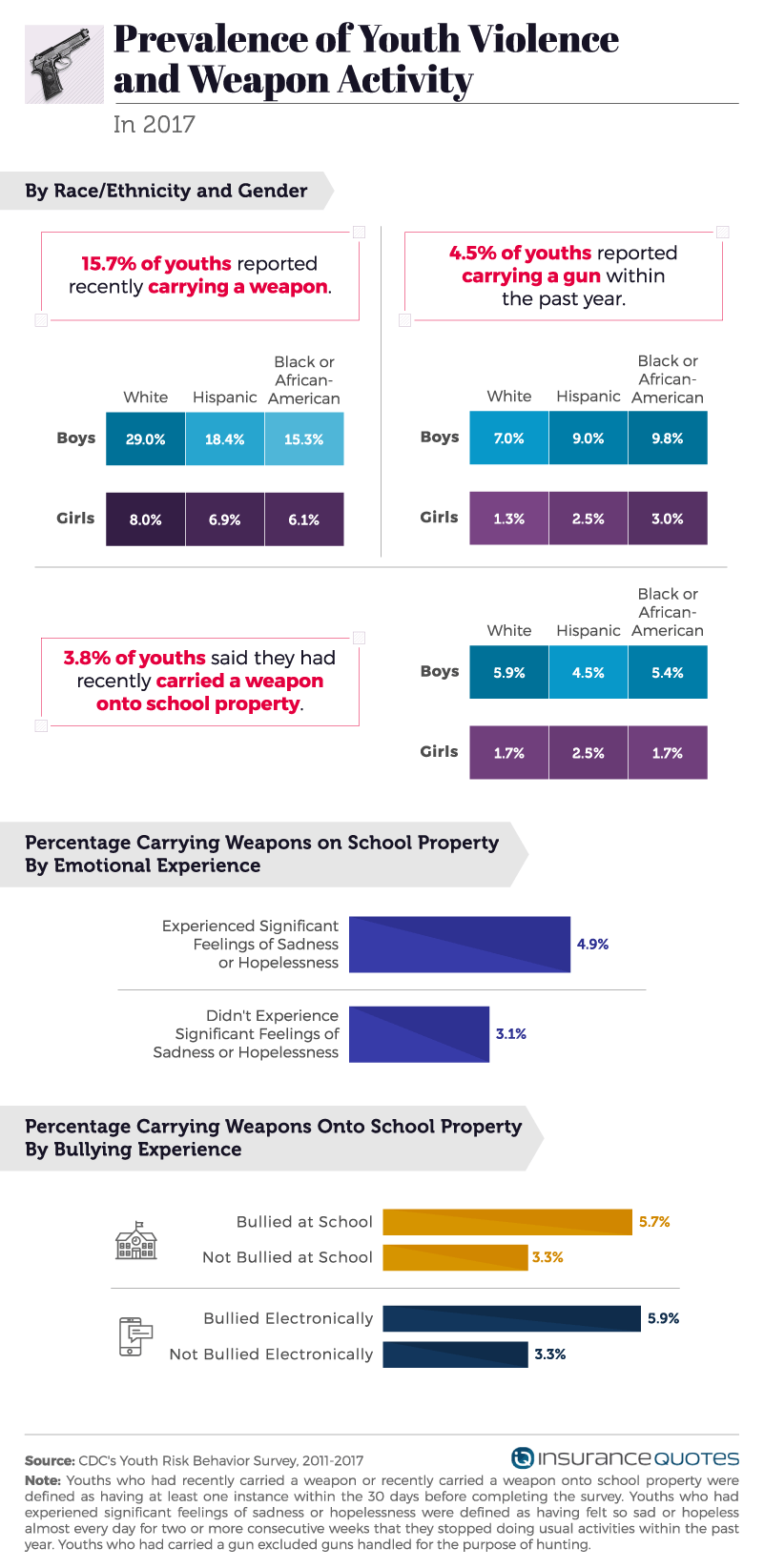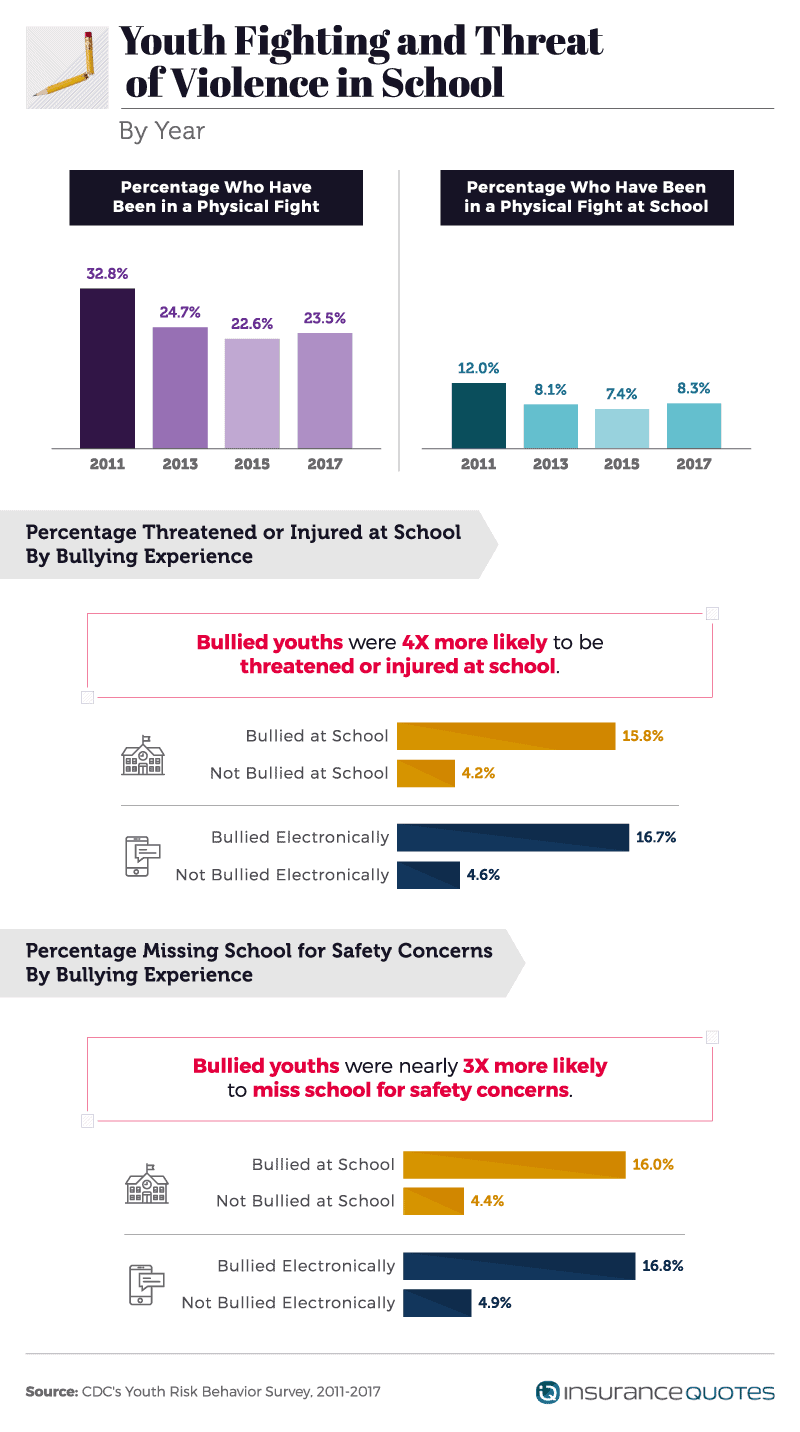Youth Bullying and Violence in Schools

Bullying is hardly a product of the 21st century, but its contemporary effects seem particularly severe. Recent years have witnessed a disturbing surge in school violence, prompting Congress to allocate over $1 billion to school safety measures over the next decade. Moreover, digital platforms can devastate vulnerable adolescents as never before: Whereas taunting once ended with the school day, the cruelty now continues at all hours on social media.
Indeed, experts believe that rising teen suicide rates may directly relate to cyberbullying, noting that smartphones give bullies constant access to their targets.
In this project, we sought to explore the true state of bullying among American teens, analyzing multiple years of data from the CDC’s Youth Risk Behavior Survey. Our findings shed light on the striking prevalence of bullying experiences and how often they escalate to violent incidents or mental health crises. For parents, educators, and teenagers, our data provide key insights into the scale and severity of the country’s bullying issues. To see what we discovered, keep reading.
Bullying by the Numbers
Our figures indicate that a large segment of American teens is threatened or taunted by their peers, in person or otherwise. One in 5 teens described being bullied at school in 2017, and 1 in 7 reported being bullied by electronic means. The annual percentage of bullied adolescents fluctuated slightly over the years studied, but a distinction among genders remained consistently evident: Female teens reported being bullied at much higher rates than their male counterparts, both in school and online. Some researchers have asserted that new anti-bullying interventions are necessary to protect young women, especially to curb harmful digital behaviors.
Gay and lesbian teens also emerged as particularly likely to experience bullying compared to peers who identified as straight. The gap was especially clear for male teenagers: The percentage of gay young men who said they’d been bullied at school was near twice the rate as their straight peers. Unfortunately, the same dynamic was evident with electronic bullying as well. LGBTQ advocates note that while much progress has been made, many high schools remain dangerous places for gay teenagers — and that incidents of violence or taunting can have traumatic effects that last a lifetime.
Suicidal Thoughts: A Concerning Situation

Although bullying obviously results in great pain, our data indicate that it sometimes produces suffering so great that victims consider suicide. Indeed, relative to peers who had never been bullied, those who reported being targeted were considerably more likely to have contemplated ending their own lives within the last year. Those who said they’d been bullied electronically were actually more likely than people bullied at school to consider suicide. In recognition of this digital risk, some parents have pushed for legislation criminalizing the abuse of minors online, even if the bully is another adolescent.
Here too, gay and lesbian teens seemed particularly vulnerable relative to their straight counterparts. Whereas roughly 33 percent of straight teens who were bullied electronically reported suicidal thoughts, nearly 67 percent of gay and lesbian teens who were targeted in this manner said they’d considered killing themselves in the last year. While these statistics are alarming, schools can take meaningful action to protect gay and lesbian students, both at school and on social media. Research indicates that programs like gay-straight alliances and anti-homophobic speech policies can reduce suicidal thoughts and attempts among high school students.
Weapons: Peril or Protection?

Bullies can inflict great harm with nothing more than their words and fists, but our data demonstrate that many teens do carry weapons on occasion. While nearly 16 percent of teens said they’d carried a weapon within the last month, male teenagers (especially white males) were much more likely to report doing so. A smaller percentage reported bringing a weapon to school recently, although, despite less than 4 percent, the rate remains alarmingly high. Concerns about weapons have galvanized an ongoing debate about the use of metal detectors at school entrances; critics assert students might find these measures disturbing or demeaning.
What might cause a student to arrive at school armed? Hopelessness and sadness may contribute to this behavior: Teens who reported these feelings were much more likely to bring a weapon to school. Of course, these very feelings could stem from being bullied: Victims of in-person and electronic bullying were more likely to bring weapons to school as well. In light of ever-growing anxiety about school shootings, these findings are especially concerning. Experts have long warned that bullying and ostracism may set troubled teenagers on a path to violent retribution, although multiple factors can contribute to these tragic incidents.
Violence and Victimization

Concerning physical violence, our data reveal an encouraging decline in fighting, both in school and elsewhere. In 2011, nearly a third of teens reported being in a fight at least once before; by 2017, less than 24 percent said the same. Likewise, 12 percent said they’d fought at school before in 2011, but just over 8 percent reported doing so six years later. Despite these positive trends, violence continues to be a leading cause of injury and death among American teens. According to CDC figures, approximately 1,600 young people go to the hospital each day due to violence-related injuries.
Bullied individuals were several times more likely than non-bullied peers to report being threatened or injured at school – confirmation that verbal harassment often escalates to real violence. These real or potential dangers understandably impact school attendance: Bullied youths were three times more likely to report missing school because of concerns for their safety. Sadly, this phenomenon raises the prospect of additional stressors. If bullying results in absenteeism, victims may find themselves chastised by parents and teachers as well or find themselves unable to graduate.
Bullying by State
Concerning bullying and teen safety, each state has its distinct challenges. In some parts of the country, we found several troubling indicators simultaneously. Alaska ranked among the top states for teens experiencing electronic bullying, considering suicide, and carrying a weapon onto school property. Arkansas had the highest rate of teens considering suicide and the second-highest rate of adolescents carrying a gun. In these cases, however, problems with violence extend far beyond teenagers: Both states rank in the top 10 for firearm deaths and violent crime overall.
Help to Stay Healthy
Our findings indicate both broad bullying hazards and specific demographics at particular risk. Indeed, young women and members of the LGBTQ community are especially likely to be targeted by bullies, and some states face urgent challenges related to cyberbullying and suicide risk. Yet, with 1 in 5 teens reporting being bullied at school, we must regard bullying as a pressing issue for the nation at large. Given the correlations we’ve uncovered between bullying and the potential for violence, we can no longer dismiss it as an unfortunate but inevitable aspect of adolescence.
For families with children who have experienced bullying, however, mental health services can provide a valuable means to maintain well-being. Unfortunately, many insurance plans offer minimal coverage for mental wellness services, so costs prevent teens from accessing the care they need. Let insuranceQuotes.com help you identify the most affordable health insurance options through our quick and discreet quote evaluation process. When you consider alternatives tailored to your particular needs, you can choose coverage with confidence.
Methodology
We obtained results from the 2011, 2013, 2015, and 2017 Youth Risk Behavior Survey conducted by the Centers for Disease Control and Prevention (CDC) to observe trends and relationships between youth bullying, violence, and weapon activity. The survey provides a nationally representative sample of youths in grades nine through 12 who attend both public and private schools. Results from the YRBS are weighted according to student sex, race/ethnicity, and grade to account for oversampling. Some variables were not available for all years.
Youths who had recently carried a weapon or carried a weapon onto school property were defined as any instance within the past 30 days of completing the survey. Youths who had carried a gun were defined as any instance within the past year of completing the survey and excluded guns carried for hunting purposes. Youths who had felt sad or hopeless were defined as those who had felt so sad or hopeless almost every day for two or more consecutive weeks that they stopped doing usual activities.
Limitations
This data are limited to only those who attend school and are not representative of all youths nationwide. The data rely on self-reporting and, therefore, is subject to selective memory, attribution, and exaggeration. Not all questions were asked for all states.
Sources
- https://www.usatoday.com/story/news/2018/08/14/school-violence-us-schools/987901002/
- https://www.cbsnews.com/news/smartphones-cyberbullying-targeted-as-causes-of-skyrocketing-teen-suicide-rate/
- https://www.cdc.gov/healthyyouth/data/yrbs/index.htm
- https://theconversation.com/combatting-online-bullying-is-different-for-girls-and-boys-heres-why-91837
- https://www.thedailybeast.com/new-study-rates-of-anti-lgbtq-school-bullying-at-unprecedented-high
- https://www.salon.com/2018/03/11/teen-suicides-rise-in-tandem-with-cyberbullying-and-advocates-have-had-enough
- https://www.cnn.com/2017/12/19/health/lgbq-teens-suicide-risk-study/index.html
- http://www.latimes.com/opinion/editorials/la-ed-school-safety-20180308-story.html
- https://www.newsweek.com/bullying-role-school-shootings-818753
- https://www.usatoday.com/story/news/nation/2018/02/21/states-most-and-least-gun-violence-see-where-your-state-stacks-up/359395002/
Fair Use Statement
Please help us spread the word about the far-reaching effects and outcomes of teen bullying. Share our images and graphics on your own website or social media for noncommercial purposes. If you do, we kindly request that you link back to this page to attribute us appropriately.
